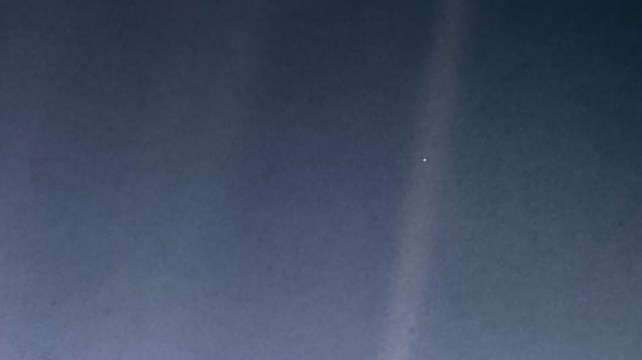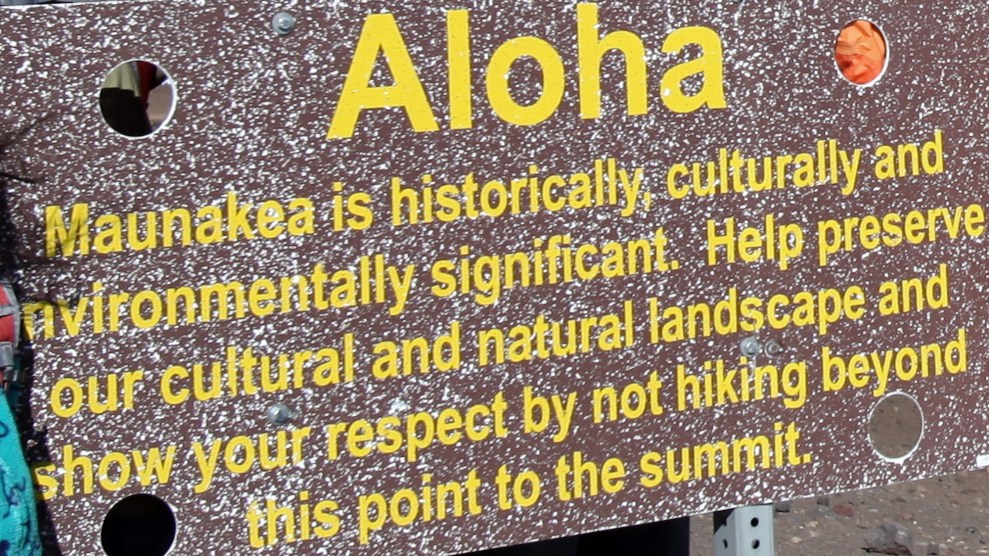
Mother Jones illustration; Getty; NASA/JPL-Caltech
On September 5, 1977, a 1,800-pound, ladle-shaped spacecraft named Voyager 1 took off from NASA’s Kennedy Space Center in Cape Canaveral, Florida, bound for the edge of our solar system. After about two months, it passed Mars’ orbit. Within two years, it made it to Jupiter, and almost two years after that, Saturn. On Valentine’s Day, 1990—34 years ago today—it looked back and snapped an image of Earth, the so-called “Pale Blue Dot,” which remains one of science’s most iconic photos, and, in my view, one of the greatest photos ever taken in the history of the world.
The first time I can remember seeing “Pale Blue Dot” was in high school. I’d won a print of the photo, appropriately, in a science fair competition. In the image, the Earth is about a pixel wide, a minuscule fleck in a grainy sea of nothingness. And that was the point: In his 1994 book, Pale Blue Dot, famed scientist Carl Sagan, whose idea it was to capture Earth from such an immense distance, famously described the image in a way that never fails to make me tear up:
Look again at that dot. That’s here. That’s home. That’s us. On it everyone you love, everyone you know, everyone you ever heard of, every human being who ever was, lived out their lives. The aggregate of our joy and suffering, thousands of confident religions, ideologies, and economic doctrines, every hunter and forager, every hero and coward, every creator and destroyer of civilization, every king and peasant, every young couple in love, every mother and father, hopeful child, inventor and explorer, every teacher of morals, every corrupt politician, every “superstar,” every “supreme leader,” every saint and sinner in the history of our species lived there—on a mote of dust suspended in a sunbeam.
Although the “Pale Blue Dot” may have looked static, in 1990, the planet, of course, was as alive and bustling as ever. At the time, the world celebrated the freshly fallen Berlin Wall; scientists had just created the World Wide Web and launched the Human Genome Project, an initiative to map the human genome for the first time; Ghost, Pretty Woman, and Home Alone topped domestic box office sales; Ralph Nader, then in his 50s, graced the cover of Mother Jones.
Thirty-four minutes after “Pale Blue Dot” was taken, Voyager 1 shut off its cameras, as it was designed to do, and continued its journey. In 2012, the craft crossed the “heliopause,” which NASA describes as “the boundary between our solar bubble and the matter ejected by explosions of other stars,” into interstellar space, or the space between stars. Voyager is still operating, but on its last legs, and is expected to have fully shut off its key science instruments sometime around 2025, NASA says.
It’s fitting that “Pale Blue Dot” was taken on Valentine’s Day. It was, in its most basic form, an act of love. Even 34 years later, it serves as a paradoxical reminder of our insignificance—and our singular source of life. It is, quite literally, our everything. And today, as our planet is plagued by violent wars, a climate crisis, and the fallout of a devastating pandemic, and in a critical election year no less, that message feels more important than ever.
Happy Valentine’s Day, dot. (And also to my boyfriend.)

“Pale Blue Dot,” taken on February 14, 1990
NASA/JPL-Caltech

















